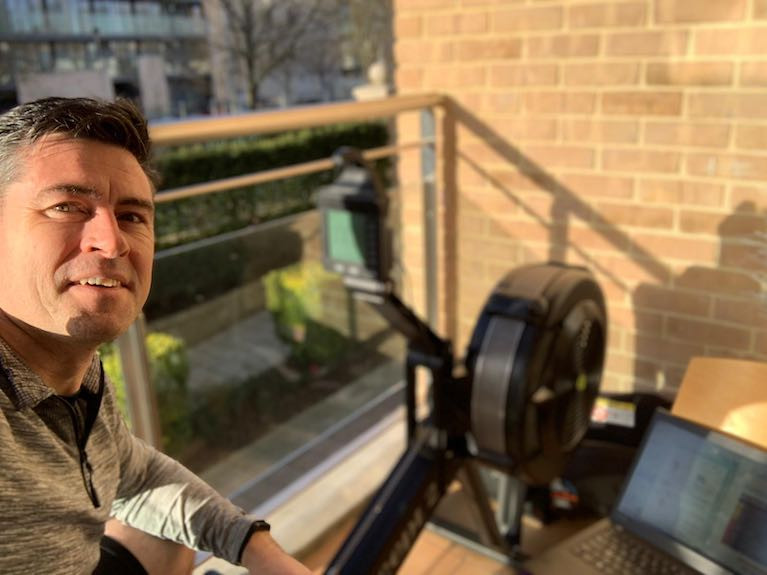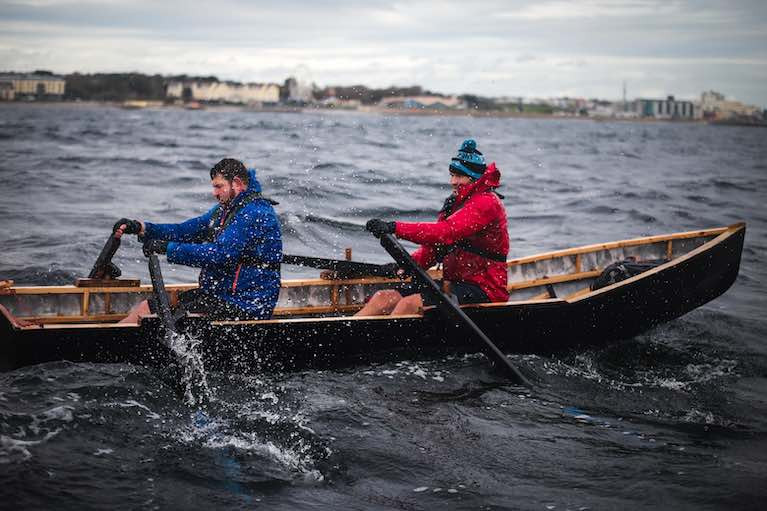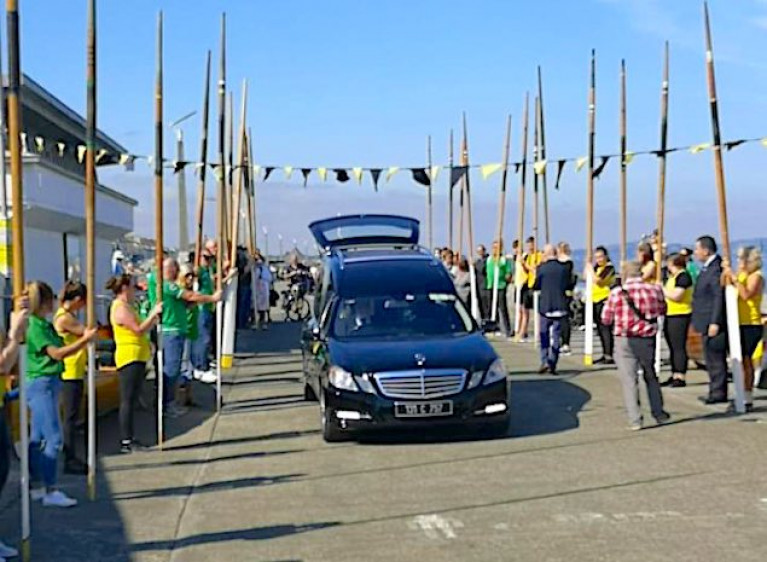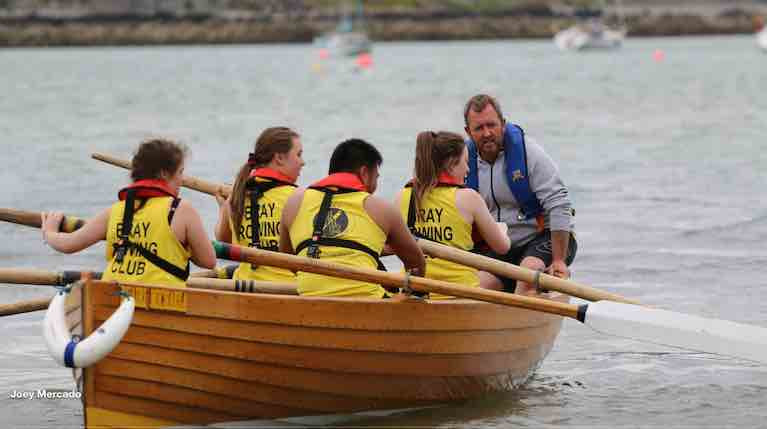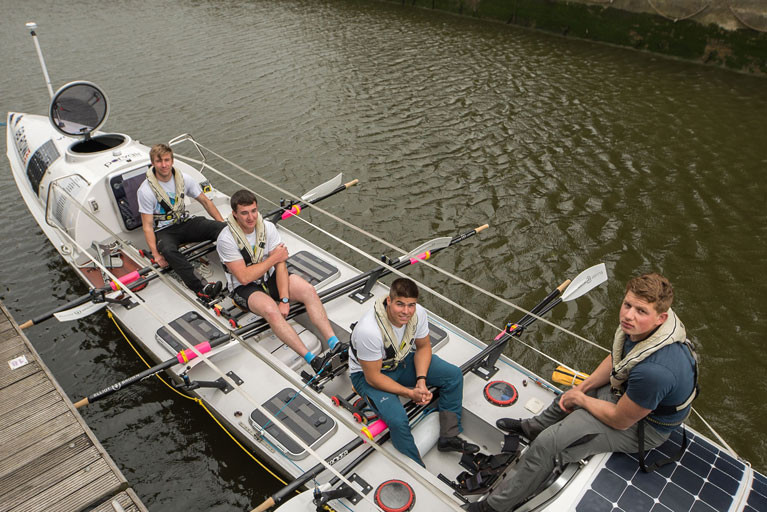Displaying items by tag: Coastal Rowing
Irish Rower Karen Weekes & Her Solo Row Across the Atlantic to Barbados (Podcast with Shore Manager Suzanne Kennedy)
Dr Karen Weekes will be spending Christmas Day, New Year’s day and more at sea on her 3,000-mile row from the Canaries to the Caribbean in her bid to become the first Irish woman to row solo across the Atlantic.
Weekes, the Kinvara-based sports psychologist and lecturer at Munster Technological University, set off in her vessel Millie, named after mother, from Gran Canaria on December 6th.
Her campaign manager Suzanne Kennedy spoke to Wavelengths about the challenges she faces, and how they have both sailed the same route – heading south till the butter melted, as Kennedy put it – and so they both have some idea of what’s ahead.
Weekes has sailed the Atlantic twice, circumnavigated both Ireland and the Lofoten Islands off Norway in a kayak, and has cycled solo and unsupported 4,000 miles across Canada, through Alaska and the Yukon.
 Dr Karen Weekes (left) and Dr Suzanne Kennedy - many adventures together
Dr Karen Weekes (left) and Dr Suzanne Kennedy - many adventures together
She has shared many adventures with Kennedy, a lecturer in physical education and sport at Letterkenny Institute of Technology and highly experienced sea kayaker, sailor and mountain biker.
As Kennedy explains, part of her focus is on researching the impact of the experience on her own psychology. The Shecando campaign also aims to provide a platform for encouraging women, and girls, to believe in their abilities to succeed”, and to highlight two of the UN Sustainable Development Goals, specifically “gender equality” and “life below water”.
Karen Weekes’s progress on her 70-day row to Barbados can be followed on her tracker on the link below, and all funds raised on the Gofundme page for Shecando2021 from the day she started rowing in December will go to two charities, Laura Lynn and the RNLI.
Listen to Lorna Siggins speaking with Weekes here and check out the tracker here
Wicklow Rowing Club Gets Mercedes-Benz Support for World Coastal Rowing Championships in Portugal
The Wicklow Rowing Club has will be supported by the Mercedes-Benz organisation in Ireland towards its participation at the World Coastal Rowing Championships which take place in Oeiras, Portugal next month.
Recognising the important role that the Club will have in being a standard-bearer for Ireland at the event, its Chief Executive, Paddy Finnegan extended the best wishes of the Mercedes-Benz organisation to the club.
Over the years, Mercedes-Benz has given its support to a number of water sport activities, most notably in its sponsorship of Ireland’s Olympic medal-winning sailor, Annalise Murphy in her preparations for the Rio and Tokyo Olympic Games and also Howth Laser ace Aoife Hopkins and prior to that Round the World sailor Enda O'Coineen in his Irish debut in the Vendee Globe Race.
If you were to bring together even half of the boats built with the involvement of the late great George Bushe of Crosshaven, you'd have the makings of a fascinating maritime museum. The master boatbuilder – whose skills live on nationally and internationally in his sons Mark and Killian – was game for any challenge, whether it was of complex boat engineering, or a world-class yacht finish. And if it came to the pinch, he was more than capable of turning his hand to boat design as well.
It says everything about the quality of George's work that he is still remembered for building a boat too well. In the mid 1950s, he was commissioned to provide one of only two International Dragons ever constructed in Ireland, in this case Melisande for ace Cork Harbour helm Joe FitzGerald.
With Melisande finished and looking exquisite, the Class Surveyor was brought over from Scandinavia to certify her as a true International Dragon. But she was rejected. It seems that George had rounded off the edges of all the bent timbers within the hull when apparently the Dragon small-print rules – in a throwback to the class's origins as an inexpensive weekend cruiser – insisted that the timbers be left basic finish, with angled edges and no fancy smoothing off.
It was quite a challenge to re-frame Melisande without damaging her superbly-finished hull, and by the time she was finally certified as a Dragon, the overall cost was well north of the economy package which had been the thinking at the class's origin in 1929.
 The traditional Crosshaven Boatyard setup of camping out in the main boatshed, complete with a small shed shed for your own gear, the spars newly varnished, and a mysterious old boat lurking alongside with a magical little transom that suggests serious ambitions in rowing races. Photo: Darryl Hughes
The traditional Crosshaven Boatyard setup of camping out in the main boatshed, complete with a small shed shed for your own gear, the spars newly varnished, and a mysterious old boat lurking alongside with a magical little transom that suggests serious ambitions in rowing races. Photo: Darryl Hughes
But getting it right was one of the many challenges George took in his stride. Another was the very Corkonian one of a local dinghy sailor ordering a new Bushe-built IDRA 14, with the deal only being finalised and the boat accepted if she had won the up-coming IDRA Nationals on Lough Derg. The word is George built the boat as the ultimate IDRA 14 of that year's crop, and then raced her himself to victory on Lough Derg, with a done deal following immediately afterwards.
With such a talent - whether ashore in the building shed or out on the racecourse – you'd think any way at all of linking a boat to George Bushe is something special. So it has been something of a wonder that in Crosshaven Boatyard, where he has been re-fitting his 1938 43ft Tyrrell classic gaff ketch Maybird, that noted mover and shaker Darryl Hughes has managed to find a very special George Bushe boat called Lorelei of early 1950s vintage, a boat which had more or less slipped away under the radar.
 All is revealed as Lorelei is turned for the first time in years – this was George Bushe's 1953 take on a serious racing skiff. Photo: Darryl Hughes
All is revealed as Lorelei is turned for the first time in years – this was George Bushe's 1953 take on a serious racing skiff. Photo: Darryl Hughes
He'd become curious about a 30ft long and very slim four-oared classic rowing skiff, dusty and hidden in the shed against the wall beside a space where he'd found some room to do the usual wellnigh perfect varnish work on Maybird's already many spars, which seem to double in number whenever varnishing time comes around.
In Crosshaven, where boats are involved, you approach such mysteries as this sidelined skiff with care and diplomacy, and it has been doubly difficult with the pubs being shut. However, eventually, it was revealed that the last known owners were the now non-functional Crosshaven Rowing Club. But the boat hadn't been used for at least twenty years, and if rowing does revive on the Owenabue River, it will more likely be with more modern design concepts which emerged from hotbeds of design development such as the Ron Holland Office.
The old hidden boat was built to race with a class of similar skiffs which were very active up in Cork City at the time, based around Marina. In her day, she must have been quite the hot property, as George incorporated lots of weight-saving techniques such as notably wide plywood planking which was edge-glued, while the reinforcing hull timbers are of minimal size. And as each rowlock had its own reinforced bracket external to the hull, he didn't feel the need to reinforce the entire gunwhale with further weight other than using a slightly heavier gauge of marine ply as the top strake.
 Seen from ahead, the lightness of construction is evident, yet there is no sign of it having been too light. Photo: Darryl Hughes
Seen from ahead, the lightness of construction is evident, yet there is no sign of it having been too light. Photo: Darryl Hughes
This makes you think that the boat must have wriggled along when they were rowing at full power, but the fact that after nearly 70 years, the hull is still in basically good order seems to indicate that George got it right.
After her period up at Marina, she was acquired by the expanding Crosshaven Rowing Club, but for at least two decades, she had become out-of-sight and out-of-mind in this hidden corner of the boatyard until Darryl came poking around.
As it's a time of change at Crosshaven Boatyard, he reckoned that the occasion was ripe for this remarkable boat to find a viable new home and guaranteed future. So having contacted the surviving members of the CRC and Mark Bushe, permission was given for Barry Saunders and the Stella Maris Rowing Club in Ringsend in Dublin to take her over, and now this remarkable craft has a new home on the banks of the Liffey, with her first appearance afloat under the new custodianship a keenly-anticipated event.
 Changed circumstances – Lorelei in her new home at the Stella Maris Club in Ringsend, her slim lines much in evidence in her first appearance in sunshine in 20 years. Photo: Barry Saunders
Changed circumstances – Lorelei in her new home at the Stella Maris Club in Ringsend, her slim lines much in evidence in her first appearance in sunshine in 20 years. Photo: Barry Saunders
Yet what, you might well ask, has all this to do with Tinseltown's blonde bombshell Marilyn Monroe? Well, the mystery skiff is very clearly named Lorelei. So it could well be that her early crews were enthusiasts for Germanic mythology and its influence on Wagnerian and other operas through the story of Lorelei, the doomed Rhine maiden.
 There's no doubting the boat's name, but why was she so-called? Photo: Darryl Hughes
There's no doubting the boat's name, but why was she so-called? Photo: Darryl Hughes
But the smart money bets otherwise. It doesn't see lusty rowing crews as being into opera, notwithstanding the importance of the Cork Opera House. However, at the time Lorelei was built, one of the great new box office movie hits was the musical Gentlemen Prefer Blondes, starring Marilyn Monroe and Jane Russell. Monroe was on top form as the showgirl Lorelei, she was at her best, and of course if a crewman's missus or girl-friend threw a frost over the boat being name after a Hollywood pin-up, the advantage of a rowing club is that you could say it was nothing to do with you personally, but everyone else seemed to want it……
Whatever, it gives us an opportunity to draw your attention to a YouTube clip which dates from a time when movies were supposed to be totally entertaining, songs were expected to be witty and tuneful, and musicals required a mind-boggling level of choreography:
Dun Laoghaire Harbour's St. Michael's Rowing Club Row Round the World in 80 Day Virtual Challenge
As we emerge from what we hope will be the country's last lockdown, St. Michael's Rowing Club based a Dun Laoghaire Harbour, is nearing completion of its longest race yet. Inspired by Jules Verne's Phileas Fogg, over the last 80 days, members and friends of the club were invited to participate in a Round the World in 80 Days challenge, virtually of course, and log their progress online writes the club's Claire Sheehan
Healthy competitiveness ensued, with times and distances uploaded, from various disciplines- kayaking, cycling, running, walking, swimming, indoor and outdoor rowing, and even surfing, an unusual sight on the east coast! All while observing Covid restrictions.
 Social distancing, 40-foot style
Social distancing, 40-foot style
Sixty-three members and friends of the club participated, clocking up a total of 33,703.7 KM and providing much-needed distraction- as these pictures demonstrate, we have a tremendous amenity on our doorstep.
 Sonja Storm swimming in Killiney
Sonja Storm swimming in Killiney
As we near the end of our journey this week, Seattle-based member Jon Phillips is speeding towards virtual victory, with locals Brendan White and David Cullen coming in for silver and bronze.
 Club member Rob Collins, kayaking at dusk in Dun Laoghaire harbour
Club member Rob Collins, kayaking at dusk in Dun Laoghaire harbour
After all that excitement, attention can at last turn to getting our youth section back in a skiff and on the water for real, and hopefully our grown-ups shortly after. It's been a long winter.
 Paddleboarders doing their bit
Paddleboarders doing their bit
Cork Harbour Festival’s flagship Ocean to City race will be going ahead this June with an altered format.
Collaborating with national rowing associations in Scotland and Wales, this year’s Ocean to City will be part of a unique, international time trial series called the Five Miles From Home Series 2021.
The Ocean to City – Five Miles From Home is the second leg in the Series, and will take place 4-6 June 2021. The challenge can be joined from anywhere in the world; rather than asking participants to travel, Ocean to City invites people to participate in this international challenge from their home waters.
Taking part is simple! Just form a crew, plot a 5 mile (8047meters / 4.345nm) course, cover the distance as fast or as stylishly as possible during the designated time windows, submit your times and join the online celebration afterwards.
 Coastal Rowing crews at a previous Ocean to City Race in Cork Harbour
Coastal Rowing crews at a previous Ocean to City Race in Cork Harbour
The Five Miles From Home Series has a ‘Main’ and an ‘Alternative’ Challenge. The Main Challenge is open to fixed-seat rowing boats such as currachs, skiffs, gigs and yawls. The Alternative Challenge is open to kayaks, SUPs, canoes, dragon boats, offshore sliding-seat boats and outriggers. Incorporating a dedicated Under-19s youth category, the organisers are also keen to involve and celebrate young people on the water.
The full Five Miles From Home Series includes the Scottish Castle to Crane leg on 7-9 May and the Welsh Sea Rowing leg on 9-11 July. Participants can take part in the whole series, allowing them to compare and improve on their results as they progress, or just in one single leg. Each leg in the series has a 48-hour window during which the challenge has to be completed.
With covid-19 constraints making large events off-limits, it is hoped that by the summer restrictions will be relaxed sufficiently to allow clubs from across Cork Harbour, Cork County and beyond to organise their own Ocean to City - Five Miles From Home micro-events.
Adrienne Rodgers, Director of Services at Cork City Council said: ‘We have been very proud to be involved in the Ocean to City Race, as part of the Cork Harbour Festival, over the years. Although like a lot of other events, it is not as we know it this year, we’re concentrating on the positive and congratulate the organisers on the wonderful alternative concept of Five Miles from Home. It won’t replace the elation of an actual race, but it will give us all a focus, to work safely towards a great event.’
Not only will the altered format encourage rowers and paddlers to get back training and competing on the water, but participants will also be part of a big international challenge connecting boating communities from across the world. Welcoming a variety of human-powered, sea-going craft, Ocean to City aims for the event to be as inclusive, adaptable and enjoyable as possible!
Mayor of the County of Cork, Cllr. Mary Linehan Foley said: ‘Cork County Council is especially proud to be a major sponsor of the Cork Harbour Festival, which has a strong legacy of celebrating seafaring culture, synonymous with Cork’s position as Ireland's ‘Maritime Haven'. We are delighted that our sponsorship of the ‘The Five Miles from Home’ initiative will help to sustain the festival despite COVID-19 challenges. Festivals and events strengthen the fabric of our communities and celebrate the very best of what our county has to offer, such as our spectacular coastline and rich maritime history. The Council’s continued support of festivals plays a key role in strengthening our tourism industry and ensuring Cork County is best placed to welcome visitors when safe to do so.’
Entries for Ocean to City – Five Miles From Home open on the 1st of March 2021 and participation costs €10 per boat per leg, or €20 for all three legs. For kayaks and SUPs it is €5 for one leg, or €10 for all three.
The organisers encourage rowers and paddlers to enter the Five Miles From Home Series with optimism and confidence. If, for whatever reason, participants are unable to complete the course on water, they can transfer their entry to the ‘Land Challenge’ and walk, wheel or run the 5 miles.
 Paddlers at the Ocean to City Race in Cork Harbour
Paddlers at the Ocean to City Race in Cork Harbour
Conor Mowlds, Chief Commercial Officer at the Port of Cork said: ‘During these challenging times, it’s really refreshing to hear that the Cork Harbour Festival’s flagship event, Ocean to City will go ahead, albeit in a different and exciting new format. The Ocean to City – Five Miles From Home is completely achievable and we would urge people to take part. Congratulations to all the team at Cork Harbour Festival, we are delighted to support this great event once again.’
Dun Laoghaire Harbour's St. Michael's Rowing Club 'Ergs' Its Way Through the Lockdown
A beautiful quote from 'The Wind in the Willows' says that 'there is nothing half so much worth doing as simply messing about in boats." Does that apply to rowing imaginary boats as well? St. Michael's Rowing Club of Dun Laoghaire Harbour thinks so writes the club's Simone Sav
Rowing on erg machines may seem artificial at times to those of us accustomed to the sharp wintery sea breeze, the team effort and the dynamic of rowing wooden skiffs or off-shore boats on the Irish sea. But, given the current COVID-19 context, this is the most respectful and considerate activity our rowing club, St. Michaels' of Dun Laoghaire, can engage with.
 Caitriona Gallagher and Simone Sav
Caitriona Gallagher and Simone Sav
We are delighted to have had 10 rowers compete in the National Indoor Rowing Championships on Saturday, the 23rd of January 2021. Five women and five men (Aoife Byrne, Catriona Gallagher, Colm Crilly, David Cullen, Gareth Wittington, Ger Ryan, Martin Dowd, Nicola Fitzgerald, Samatha Nagle, Simone Sav) competed in 11 races and won four medals, along with Personal Best results. This is the fifth major competition that our members engage in within the last four months on national and international level (3rd of October, 24th of October, 21st November 2020 - for national competitions and 5th December 2020 for the British Indoor Rowing Competitions), with 11 medals won overall. Special mention to Niall O'Toole and his online training sessions many of us follow on a weekly basis.
 Gareth Whittington and Nicola Fitzgerald
Gareth Whittington and Nicola Fitzgerald
As an amateur rower, it takes courage to compete against established athletes. Those minutes before the start of a race, when one has to find its breath, remember their strategy, and retain their self-confidence are always tough. But we are delighted, that, somehow, we do. Consistently. Stubbornly so.
 Ger Ryan
Ger Ryan
Hilary Lovejoy, Club Chairperson, says: 'Our club, along with many other rowing clubs, has to face the challenge of remaining meaningful to its members when normal activities cannot take place. And with good reason. Staying safe, at home, is a solution recommended by the Government to prevent the spread of COVID-19, which we embrace and uphold. We are delighted that so many of our members signed up for this national competition.'
 Aoife Byrne
Aoife Byrne
'We are a coastal rowing club,' says Gary Byrne, Club Captain. 'In normal circumstances, we would offer winter rowing to our members, which is not possible now, due to the pandemic context. We look forward to being back on the water as allowed by the Government but in the meanwhile, we are delighted with our members' results in the Indoor Championships. Fantastic results and congratulations to all participants.'
 Sam Nagle
Sam Nagle
Besides participating in the Indoor Rowing Championships, St. Michael's RC, Dun Laoghaire, will also get involved in providing training sessions on how to read the weather in Dublin Bay for its members in February.
Aran-Galway Currach Row Marks Transatlantic Bid
When Fergus Farrell was paralysed after a workplace accident, he may never have imagined he would watch the sunrise as he plied a currach across Galway Bay.
However, the former rugby player did just that with close friend and extreme sports athlete Damian Browne this week, when the pair completed a 40 km (25-mile) row from the Aran islands into Galway city.

As Afloat reported previously, The row – which took place the morning after Galway city was embroiled in controversy over a large student gathering at Spanish Arch – was completed in less than nine hours.
The pair aimed to highlight their bid to set a new Guinness world record in an unsupported row some 4,937km across the Atlantic in two years’ time.
The two men from Renmore and Athenry have been friends and players with Connacht and Galwegians Rugby Football Club since they were young.
Farrell was diagnosed with a serious spinal cord injury after a workplace accident in 2018.

After treatment in the National Rehabilitation Hospital (NRH) in Dun Laoghaire, Co Dublin, he walked 206 km from the place of his accident to the NRH in late October 2019, and raised €70,000 for the hospital.
Browne successfully rowed across the Atlantic solo in late 2017-early 2018, enduring nine-metre high swells, head lacerations, a complete steering system failure, a capsize in a storm and a near-miss from a cargo ship.
He completed the crossing in 63 days, 6 hours and 25 minutes.
He has completed the six day, 257km-long Marathon des Sables across the Sahara, and has climbed five of the seven summits or highest peaks on each continent, with Everest in his sights for next spring.
The record of 55 days and 13 hours for an Atlantic crossing from New York to the Scilly Isles was set in 1896 by George Harboe and Frank Samuelsen. They had none of the satellite communications and safety equipment available now for such ventures.

Some 11 pairs have attempted to break that record but failed, with six of the 11 completing the crossing.
There have been 52 previous attempted crossings in an unsupported row, with 18 successfully making land in some part of Europe.
Browne and Farrell’s transatlantic bid is named Project Empower, and their ocean rowing boat will be built by master builder Justin Adkin of Seasabre, who also constructed Browne’s vessel for his solo crossing.
Website here: http://www.projectempower.ie/
Final Visit of Bray Rowing Club Founding Member Mr Noel Walsh
Bray Rowing Club said goodbye to its founding member and legend Mr Noel Walsh yesterday (Tuesday, September 16) writes club member Mick O'Toole
Noel, we thank you for your years of commitment and selfless dedication to Bray Rowing Club. A true community man, gone but never forgotten. We will make sure that your years of service to the club will not be in vain and strive to continue the high standards you have set. There is no doubt that the rowing club would not be where it is today without you. You have paved the way for rowing in Bray for generations to come. We are forever grateful.
The sea stood still and the sun shone through for your send-off, something we always pray for on regatta day.
We would like to thank everyone who came to give Noel the send-off he deserved, the turnout was overwhelming and no doubt he was looking down on it a very proud man.
A special thanks to the other clubs on the east coast for making the long journey to show support for Noel. The east coast rowing community stood tall yesterday and it was a testament to the character of the people in the rowing community.
We send our condolences to Anne, John and the extended family.
Rest in Peace Noel, till we meet again my friend.
An inaugural coastal rowing event on August 22nd between Bray Rowing Club and Greystones Rowing Club will feature a traditional skiff rowing challenge along the coastline of Bray and Greystones in County Wicklow.
Spectator viewing will be possible all along the cliff walk from 7 am until the teams reach a distance of 500kms.
The event is to raise funds for a safety boat and to encourage participation in rowing. All of sports Ireland safety guidelines are being followed regarding Covid-19 and social distance.
The Challenge is for each club to row 250 km culminating in a total rowing distance of 500 km. Multiple crews will row legs of the journey starting in Bray and Greystones.
Both clubs would like to be able to increase their youth membership and continue to offer all adult rowers an opportunity to improve their physical and mental well-being. Crews will be made up of all club members from 14 years old to senior rowers working together to achieve a common purpose.
Bray Rowing Club urgently need funds to facilitate its growing membership. The funds raised during the 'Braystones' event will be used to purchase a safety boat.
The purchase of this boat is essential for the clubs continued participation in the regatta series.
A GoFundMe page is available for donations has been set up here.
GB Rowing Challenge Calls at Glenarm Marina
An unusual visitor to Glenarm Marina in County Antrim recently was the rowing boat of the GB Row Challenge. After what must have been an uncomfortable time lying in the open in Glenarm Harbour in a north-westerly, the GB Row Challenge berthed alongside a pontoon, permissible for safety reasons.
This event is the ultimate rowing challenge and covers about 2000 miles. Complex tides and very changeable weather mean good navigation skills are required, as well as the tactical ability to make the most of weather and sea conditions, which can be as important as a team’s strength, stamina, and endurance. The race is organised by rowers who have been there themselves, meaning GB Row’s priority is to ensure teams have an enjoyable and safe race round the spectacular British coastline.
Making up the team are skipper Charles Bromhead (21), Oliver Daw-Lane (21) Harry Lidgley ( 22) and Arthur Chatto (20). In these COVID 19 times, they have been living together and as a result are able to race. The money raised will be split between two great causes; The British Red Cross to help with the Covid-19 efforts and Just One Ocean who are committed to preserving the ocean for future generations. The team have been taking water samples for plastics and carrying out acoustic recordings to test sound pollution in the sea. The acoustic recordings will be analysed by RS Aqua and Portsmouth University and it is expected that the water sample testing will be done there too.
They are also aiming to beat the current Guinness World Record for a UK team rowing unaided around Great Britain which was previously also set by a team led by Will de Laszlo in 2005 at 21 days, 21 hours and 14 minutes.
On board is 35 days’ worth of food and they started on 5th July from London’s Tower Bridge. At the time of writing (9th Aug), they are off the Firth of Forth on the East Coast of Scotland so might have to go easy on the rations or do a bit of fishing!
From Tower Bridge, they headed west down the English Channel and encountered very heavy weather before rounding the Lizard to head across the Bristol Channel and up the Irish Sea. From Glenarm, they continued up the North Channel past the stunning Antrim Coast with its impressive headlands and strong tides, round the most northerly point of the British mainland at Dunnet Head and through the Pentland Firth. Now it’s a southerly passage and you can track the boat at undefined
Event owner of GB Row Challenge Ltd., William de Laszlo is keen to encourage interest in the challenge. He says “You can be any nationality, men or women and can sign up. Entries for 2021, 2022 and 2023 are now being accepted”.




























